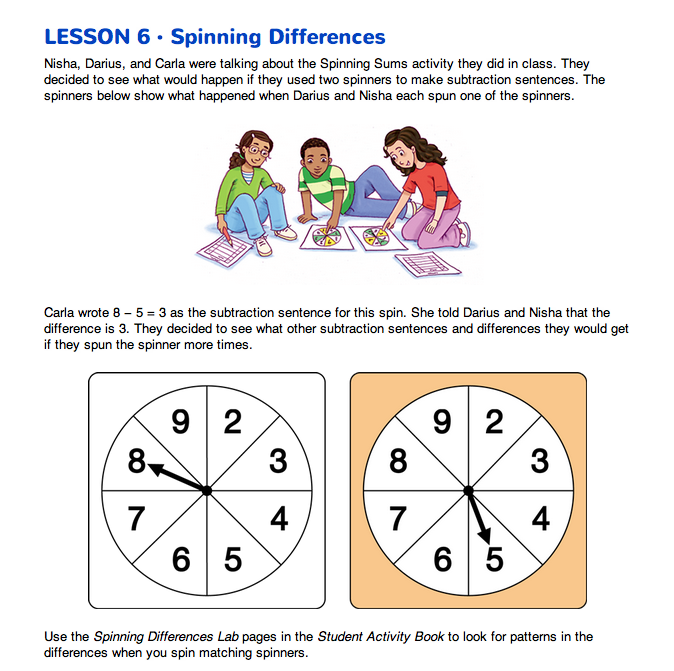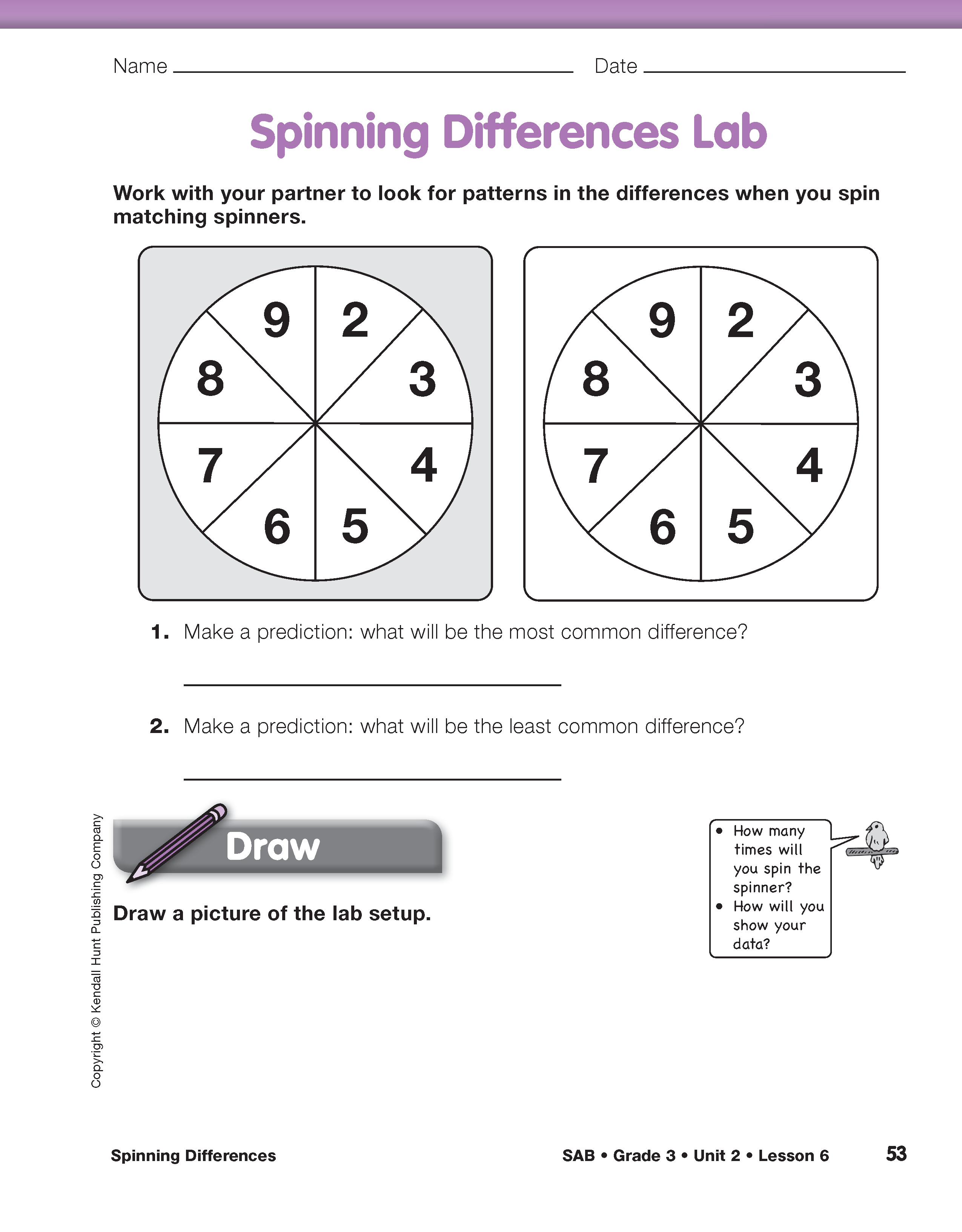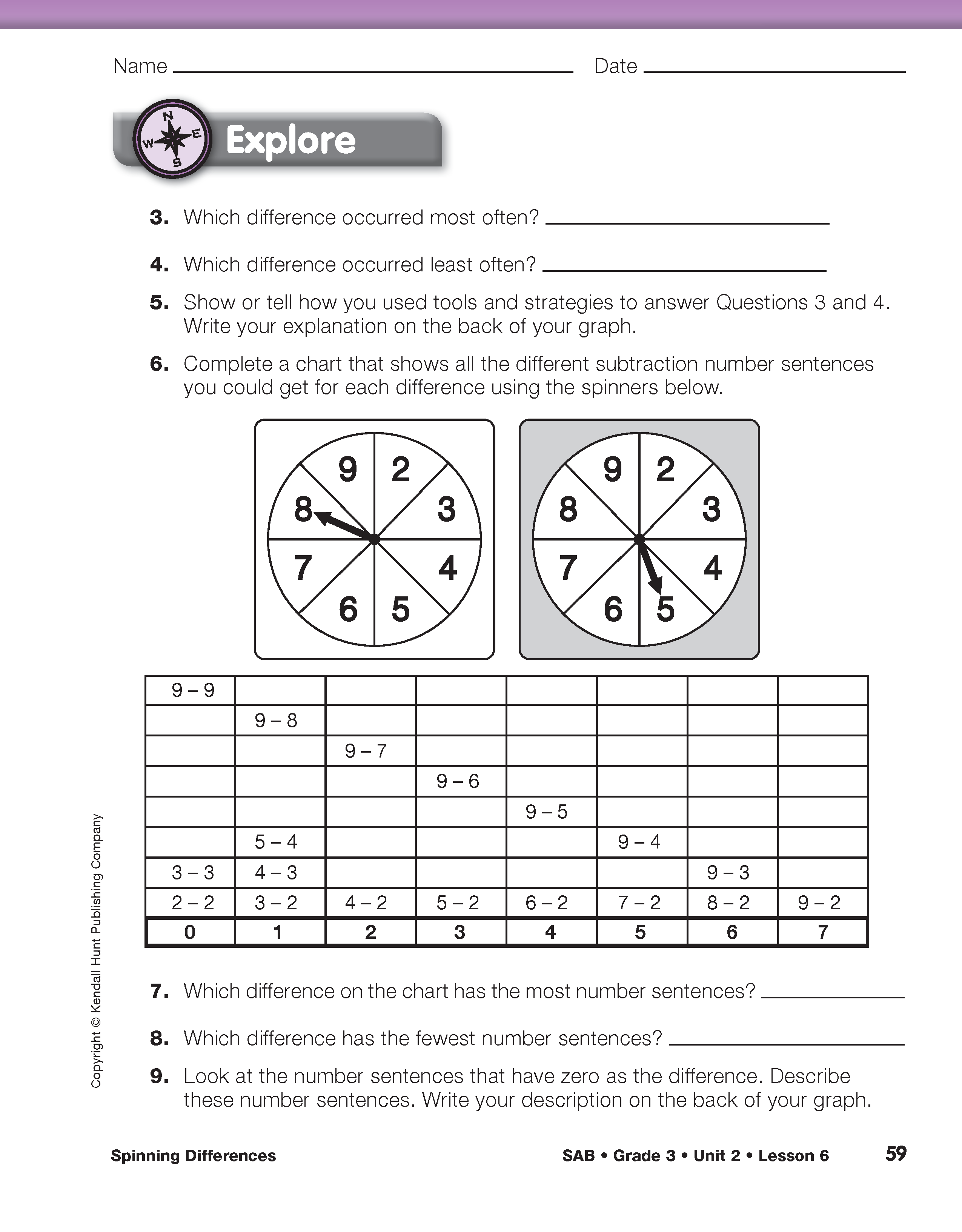Introduce Spinning Differences. Ask students to open to the Spinning Differences page in their Student Guide. Use this page to introduce the Spinning Differences Lab in the Student Activity Book. Use the following discussion prompts.
- Think about the Spinning Sums lab that you completed in Lesson 3. What did you find out about the sums you get when you spin the two spinners? (There is only one way to spin a sum of 4 or 18. The middle numbers, 11 or 12, are the most common sums because there are many ways to spin them.)
- When you completed the number sentence chart for Spinning Sums, why did you have more number sentences for the sum of 11 than you did for the sum of 5? (The only two numbers you can spin to get a sum of 5 are 2 and 3. You can make two different number sentences with these numbers: 2 + 3 = 5 and 3 + 2 = 5. You can spin four different combinations of numbers to get a sum of 11. You can make eight different number sentences with the numbers: 2 + 9 = 11; 9 + 2 = 11; 3 + 8 = 11; 8 + 3 = 11; 4 + 7 = 11; 7 + 4 = 11; 5 + 6 = 11; and 6 + 5 = 11.)
- In an addition problem, the answer is called the sum. What do you call the answer in a subtraction problem? (It is called the difference.)
- How do you think Carla decided which number should be first in the number sentence she wrote? (I think Carla put the 8 first because it is the larger number.)
- What do you think Carla and Darius will find out about the differences they will get if they spin more times? (Possible response: They will see a pattern like we did for Spinning Sums—most of the differences will be in the middle.)

Larger numbers can be subtracted from smaller ones, yielding a negative result. Since students have not yet encountered negative numbers, they are likely to use the larger number first without instruction. Avoid advice such as, “you can't subtract a larger number from a smaller one” since it may confuse students when they later encounter negative numbers.
Direct students to the Spinning Differences Lab pages in the Student Activity Book. Have students work with their partner to read the problem carefully. The procedure for this lab is similar to the procedure used during the Spinning Sums Lab in Lesson 3. In addition to the Spinning Differences Lab pages, each pair should have the two clear plastic spinners or a pencil and paper clip.
Review student work and use the Feedback Box at the end of the Spinning Differences Lab in the Student Activity Book to assess students' progress toward making generalizations using tables and graphs [E1] and identifying patterns in differences [E3]. Use Question 5 to assess students' abilities to find a strategy [MPE2] and to show their work [MPE5].
Before students begin their work, review the Math Practices page from the Reference section of the Student Guide with them. Refer students to Find a strategy [MPE2] and Show my work [MPE5]. Remind students to use these two Expectations to guide their work as they complete the Spinning Differences Lab pages.
Collect and Record Data. Once students understand the problem, your role in the students' process should be minimal. Let pairs decide how many times to spin the spinners, how to organize their data, and how to scale and label their graph. Students then predict the most and least common differences in Questions 1–2. Once the pairs have collected and recorded their data, they should discuss their results. Each student should then work independently to complete Questions 3–5 in the Explore section. (Data Table and Graph minis are in the answer key.)
Review Student Work. After students have collected and organized their data and completed Questions 1–5, direct their attention back to the Math Practices page. Use the following prompts to guide a discussion about Math Practices Expectations 2 and 5.
- What tools did you use? (Possible response: I used spinners to make the number sentences. I wrote the number sentences on the data table and then used the graph to graph all the differences.)
- What strategies did you and your partner use? (Possible response: We took turns spinning the spinners, then we decided what number sentence to write on our data table. We decided to spin 30 times so we would have enough number sentences. We made a graph to show all our differences. We used the data to figure which differences are most common and least common.)
- For Question 5, what did you write or draw so someone can understand your thinking? (Possible response: I told how many times I spun the spinners. I told how I used the data table to record the number sentences and the graph to show the number of times I got each of the differences. I told how I found out which difference was most common and which difference was least common.)
After completing this discussion, ask students to work with their partners to review each other's work using Math Practice Expectations 2 and 5. Students can refer to the Math Practices page to make suggestions for revisions. Based on the feedback they receive, students should revise their solutions and explanations before handing them in.
















